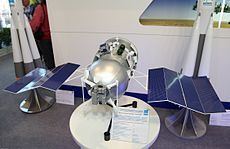Mission type Research SATCAT no. 39130 Bus Hybrid Yantar/Zenit Period 1.6 hours Dates 19 Apr 2013 – 19 May 2013 | COSPAR ID 2013-015A Spacecraft type Bion-M Mission duration 30 days Rocket Soyuz-2 | |
 | ||
Website biosputnik.imbp.ru/eng/bion.html Operator Russian Academy of Sciences | ||
Bion-M No.1 (Бион-М) is a Russian space mission, the part of the Bion series of space missions.
Contents
Launch
The animal-carrying space capsule was launched into orbit on 19 April 2013, from Baikonur Cosmodrome, Kazakhstan. The Bion-M flew a 30-day mission.
Return to Earth was on 19 May with a landing near Orenburg in Russia at 03:12 GMT.
Satellite
The satellite contains parts from two long standing Soviet spy satellite families. Bion's landing unit is from the Zenit 2M satellite and the satellite also contains the instrument section of a Yantar. It was made by TsSKB Progress of Samara.
The cargo consisted of 45 mice (three per cage), 15 geckos, eight Mongolian gerbils, snails, and fish. The animals were intended to survive the entire mission, but upon landing it was found that all gerbils, most of the 45 mice, and all of the fish were dead due to equipment failure. Fifteen of the mice died when the food dispenser in their experimental compartment stopped working. The gerbil compartment suffered a temporary loss of power, ventilation, lighting, and food supply that likely accounts for their demise. Ultimately, all of the remaining animals will be euthanized for study. The Bion-M No.1 mission is managed by Roscosmos, but scientists from the United States, Germany, Canada, Poland, the Netherlands and other countries are participating in the experiments.
It was launched with 6 small satellites - OSSI-1, Dove-2, AIST 2, BEESat 3, SOMP and BEESat 2.
Research
Research based on the recovered animals has revealed insights into the impact of spaceflight on cerebral arteries, the spinal cord, inner ear, and genetic processes. Deputy Director of Russia's Institute of Medical and Biological Studies Vladimir Sychev indicated that some of the results may help explain why some astronauts suffer impaired vision during spaceflight: "We used to think that in zero-gravity, fluid travelled upward and that the quality of blood improved, but it turns out that it is the other way around. The arteries of the brain come under duress and their capacity is reduced by 40 percent." The reduced bloodflow may be key to triggering orthostatic intolerance.
